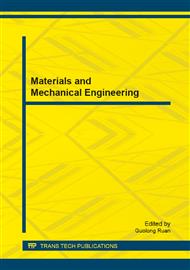[1]
Chen L.Q. Policy Support for New Energy Automotive Industry Development, J. Journal of Nantong University(Social Sciences Edition), 2010, 26(04): 124-133.
Google Scholar
[2]
Ma Z.F. Basic Science Research for Electric vehicles Used Low Cost, High-density Storage (hydrogen) System, Charter, M. Beijing: Ministry of Science and Technology, (2007).
Google Scholar
[3]
Wei X.Z. Reaserch on management system of Fuel cell cars lithium-ion battery. D. Tongji University, (2005).
Google Scholar
[4]
Ma Z. Y, Zhang D.Y. Technology of Electric Hybrid Hydrogen Fuel Cell Vehicle Power System ,J. Chinese Journal of Power Sources. 2008, 32(06): 357-360.
Google Scholar
[5]
Xiao H.Q. Fuel Cell Electric Vehicle Power System Control Strategy, D. East China University Of Science and Technology, (2012).
Google Scholar
[6]
Andrew F. Burke. Batteries and U1tracapacitors for Electric, Hybrid, and Fuel Cell Vehicles. Proceedings of the IEEE, 2007, V01. 95: 806-820.
DOI: 10.1109/jproc.2007.892490
Google Scholar
[7]
South China University of Technology. A Fuel Cell - Lithium-ion Battery Hybrid System, Chinese patent: CN 102555765 A, 2012-07-11.
Google Scholar
[8]
Yu M., Weng Z.X. Selection and Design of Fuel cell Vehicle Power System, J. Science & Technology Information, 2009 (10): 510-511.
Google Scholar
[9]
Jennifer Bauman. A Comparative Study of Fuel-Cell-Battery, Fuel-Cell-Ultracapacitor and Fuel-Cell-Battery-Ultracapacitor Vehicles. IEEE Transactions on Vehicular Technology, Vol. 57, No. 2, March (2008).
DOI: 10.1109/tvt.2007.906379
Google Scholar
[10]
Wang P, Huang X.F. FCV Hybrid System Parameter Matching and Optimization, J. Shanghai Auto, 2010, (03) : 7-11.
Google Scholar
[11]
Xin N.L. Thermal Characteristic Analysis and Simulation Research of Lithium-ion Power Battery Pack for Pure Electric Vehicle ,D. Jilin University. (2012).
Google Scholar
[12]
Sun X.Q. Design and Simulation of the Powertrain of Hydrogen Fuel Cell Vehicle, D. Wuhan University of Technology. (2012).
Google Scholar
[13]
Research and Development of Fuel cell-lithium-ion Battery Hybrid Light Electric Vehicle , J. Management and Research on Scientific & Technological Achievements. 2012(01): 87-88.
Google Scholar
[14]
Keshav S. Varde, Deepak J. Frank . Characterization Of A PEM Fuel Cell Stack Transient Conditions And Its Use In Simulating A FC Powertrain. Proceedings of ASME 2009 Seventh International Fuel Cell Science, Engineering and Technology Conference. Fuel Cell 2009 June 8-10, 2009 Newport Beach, California, USA.
DOI: 10.1115/fuelcell2009-85020
Google Scholar
[15]
Wenzhong Gao. Performance Comparison of a Fuel Cell-Battery Hybrid Powertrain and a Fuel Cell-Ultracapacitor Hybrid Powertrain. IEEE Transactions on Vehicular Technology, Vol. 54, N0. 3, May (2005).
DOI: 10.1109/tvt.2005.847229
Google Scholar
[16]
Schlapbach L, Zittel A. Hydrogen-storage materials for mobile applications, J. Nature, 2001, 414: 353-358.
DOI: 10.1038/35104634
Google Scholar
[17]
Chen C.P., Wang X.H., Chen L.X. Development and Application Status of Fuel cell Vehicles on Board Storage System Technology, J. Acta Energiae Solaris Sinica, 2005, 26(3): 435-442.
Google Scholar
[18]
PHILLIPS A B, SHIVARAM B S. High capacity hydrogen absorption in transition metal-ethylene complexes observed viananogravimetry, J. Phys Rev Lett, 2008, 100(10): 105505.
DOI: 10.1103/physrevlett.100.105505
Google Scholar
[19]
LIU Y, KABBOUR H, BROWN C M, et al. Increasing the density of adsorbed hydrogen with coordinatively unsaturated metal centers inmetal-organic frameworks, J. Langmuir, 2008, 24(9): 4772-4777.
DOI: 10.1021/la703864a
Google Scholar
[20]
LI Y W, YANG R T. Significantly enhanced hydrogen storage in metal-organic frameworks via spillover, J. J Ameri Chem Soc, 2006, 128(3): 726-727.
DOI: 10.1021/ja056831s
Google Scholar
[21]
Wang J. L, Wang D. F, Chen S.M. Testing and influencing factor for efficiency of vehicular fuel cell, J. Journal of Guangxi University(Natural Science Edition). 2010, 35(06): 989-994.
Google Scholar


